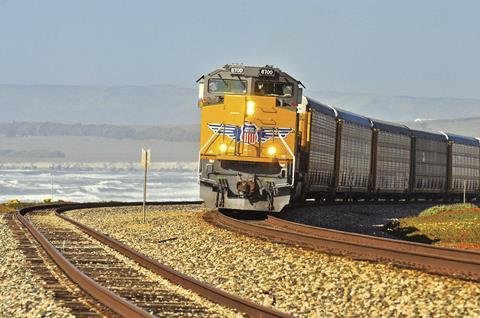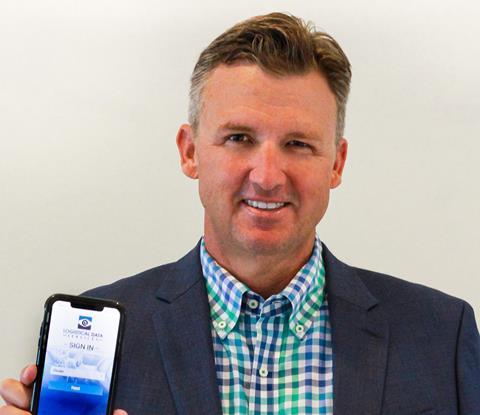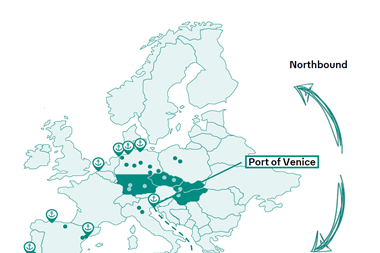Vehicle condition reporting is vulnerable to error, but US-based Logistical Data Services says transit times and damage can be reduced by the accuracy and accessibility of its real-time inspection technology

From plant to dealer, a slick supply chain should deliver high quality vehicles to consumers. However, with multiple companies often handling the product, the challenge from an OEM’s perspective is how to accurately report the condition of the car throughout the process.
“People can do so much, but if they don’t have good systems feeding them information in a timely and transparent manner, it makes the job more difficult,” says Eric Gettemy (pictured), president, LDS.
“Everyone has a role in this process, whether it be the OEM, the railroad or the trucking company, but without real-time condition analytics, the industry faces a lack of consistent process at the dealership for delivery process, a lack of transparency of exceptions identified by the dealer and a delay in claims notifications to responsible parties.”
Logistical Data Services (LDS) was formed five years ago to fill a gap in the market for a true third-party analytics and claim prevention company with cutting edge technology. Aiming to connect customers to data that is critical to their businesses, the company designed a technology platform which can be customised for each customer to provide real-time data.
“We felt technology was lagging behind in terms of the data tools available, and so we created custom analytics for each party, offering real-time inventory, expediting claim processing and ensuring accuracy,” says Gettemy.
Dealing with data
The system consists of a mobile app, which allows complete verification inspections using an Android phone or scanner from manufacturing to dealership. LDS receives data from the vehicle at multiple points on its journey from plant to dealer, and the history and condition of the vehicle are located on one platform.
“At the yard facility a driver or unloader records data onto the platform,” explains Gettemy. “We’ve got a live real-time update condition of the vehicles as they progress from the plant to the dealership.”

By scanning the vehicle identification number (VIN), any damages upon inspection can be photographed and uploaded. Reports are then sent to the cloud, and are turned into a comprehensive and accurate damage report, which is automatically sent to the transporters.
LDS inspects millions of vehicles at assembly plants. “We control that data and then we also aggregate any other inspection data provided by other sources into our database and then at every junction point from plant to dealer. There’s a myriad of routes and we either put the data in the system physically or we pull it from the OEMs’ sources, to give the full picture of that vehicle,” says Gettemy.
“As we get closer to collecting the data, we can provide real-time access to the condition and, more importantly, where that vehicle is in the cycle. Ideally, a dealer could log into our app and see where the vehicle is and why it’s being held up. It may be out for repair, for example. Ultimately we have the ability to reduce transit times and damage.”
Facilitating OEM deliveries to their dealer networks
LDS is working with all members of the automotive supply chain from plant to dealer, including all major railroads, haul-away, insurance companies, marine and trucking customers, and many of the OEMs directly.
One OEM is currently trialling LDS’ technology at four of its dealerships. The LDS dealer check-in app upon successful completion of the OEM/LDS pilot will eventually be rolled out to all the OEM’s US and Canada dealers, which will use the LDS technology to check-in millions of cars per year. Not only will the LDS app standardise the vehicle check-in process at the OEM’s dealerships, it will enable dealer inspectors during the vehicle inspection process to document the condition of the vehicle at time of delivery as opposed to being dependent on the driver’s input into their electronic proof of delivery (ePOD) or on the delivery receipt.
This partnership will also allow the OEM’s claims adjudicators to see the noted exceptions that were identified at previous touch points wherever the LDS app was used in the vehicle transportation network. Other benefits to the dealer include a standardised notification of damage emailed immediately to the carriers for after-hours deliveries subject to inspection and a trigger to let the dealer know if a vehicle has been delivered after-hours, but has not yet been checked-in on the app. This function is essential when vehicles are dropped in the wrong locations within the dealer’s lot overnight, says LDS. The trigger that a vehicle has been delivered, but not checked-in enables the dealer to meet the industry standard 48-hour requirement to notify the carrier of any damage found upon inspection.
”We have a platform which will change the standard of how vehicles are delivered to the dealer and how they receive them” - Eric Gettemy, LDS
The LDS app automatically records the date, time, and GPS location of where the inspection takes place, along with who delivered the vehicle and who received it, creating an equitable process for all parties concerned related to the condition of the vehicle at time of delivery, says the company.
Dealers and OEMs will have access to all the inspection details, including images, to aid in a far more fair and accurate initial claims adjudication process, says LDS. The app also provides an alleged industry-first dealer input confirmation of dealer receipt of a vehicle, which means the OEM can see that the dealer and not the carrier confirmed they have received the vehicle.
“The app can be used at all the OEM’s dealerships in the United States and Canada, which will facilitate the inspection and confirmation of delivered finished vehicles” - Eric Gettemy, LDS
The OEM pilot is also investigating further opportunity for the use of the vehicle check-in app at their non-dealership final destinations such as modifiers, upfitters, rental car facilities and ports. The platform stores records of vehicle inspections in an online dashboard that is accessible to the dealer for all units they have received. The OEM and their authorised agents can view the same data for all units received that were checked-in at dealers using the LDS app.
“The app can be used at all the OEM’s dealerships in the United States and Canada, which will facilitate the inspection and confirmation of delivered finished vehicles. We have a platform which will change the standard of how vehicles are delivered to the dealer and how they receive them,” says Gettemy.

“The platform will provide the necessary support to establish electronic data interchange or file transfer protocol connections to share dealer inspection data between the OEM, LDS, and other OEM authorised third-party systems.”
Track and trace
LDS provides its real-time inspection services in the US, Canada and Mexico. “We inspect every vehicle coming over the Mexican border domestically, which is about 2m vehicles a year,” says Gettemy. “Our team goes up onto the railcars and determines what the condition is of vehicles coming across the border. There is a huge issue regarding missing keys, fobs and wired rail car doors. It’s the most significant issue facing the automotive industry, rail-wise, today.”
LDS also provides all third-party data and inspection services for the Union Pacific Railroad freight hauling company. “The Union Pacific has had a strategic relationship with the leadership of LDS for over 20 plus years through different organisations,” explains Keith Lee, general director, Union Pacific. “When I returned to the Union Pacific Shipment Quality department over 19 months ago, I challenged our automotive inspection supplier base to think differently on the value they provide to their customers; we need technology that will drive value to the automotive supply chain.”
LDS subsequently developed a process and application that would give the haul-away base the ability to loading vehicles faster without waiting for LDS to physically verify damage. “This decreased vehicle dwell benefits both Union Pacific operations and our valued customers,” says Lee.
In five years, LDS has grown to over 250 full time employees and currently operates in 87 locations, including plants, rail ramps and ports. The company says it is looking for industry partnerships where it can help different industry groups get data in the format they need.
“Our goal is to get the product to the dealer damage free and on time, to make their experience better,” says Gettemy. “We’re giving customers a lot of options. In terms of services, some want us to do the work and include inspections as part of their system, some just want our systems, and some want both.
“Our goal is to get the product to the dealer damage free and on time, to make their experience better” - Eric Gettemy, LDS
“If the companies can give us the format to their systems, we can pull off the data and give it to them as they need. We often hear that organisations struggle to get anything accomplished internally because their IT departments are so big and they are so far down the list. We can step in and custom-fit a user-friendly application in an in-house IT department.”
Dennis Manns, former lead executive for American Honda’s North American finished vehicle logistics, explains that he focused on three key areas during his tenure there: best-in-class network design, award-winning vendor partners and state-of-the-art systems which improved the company.
“Every OEM is looking for customised systems solutions,” he says. “The LDS team is a vendor partner that provides customised industry leading system solutions – they are truly driven by results. Having spoken to their customers, it is exciting to have a partner that delivers innovative logistic solutions.”
Gettemy concludes: “We believe we are very close to providing the industry with a platform which will reduce costs and make every aspect of the transportation cycle more efficient, for every stakeholder in the process.”




































No comments yet